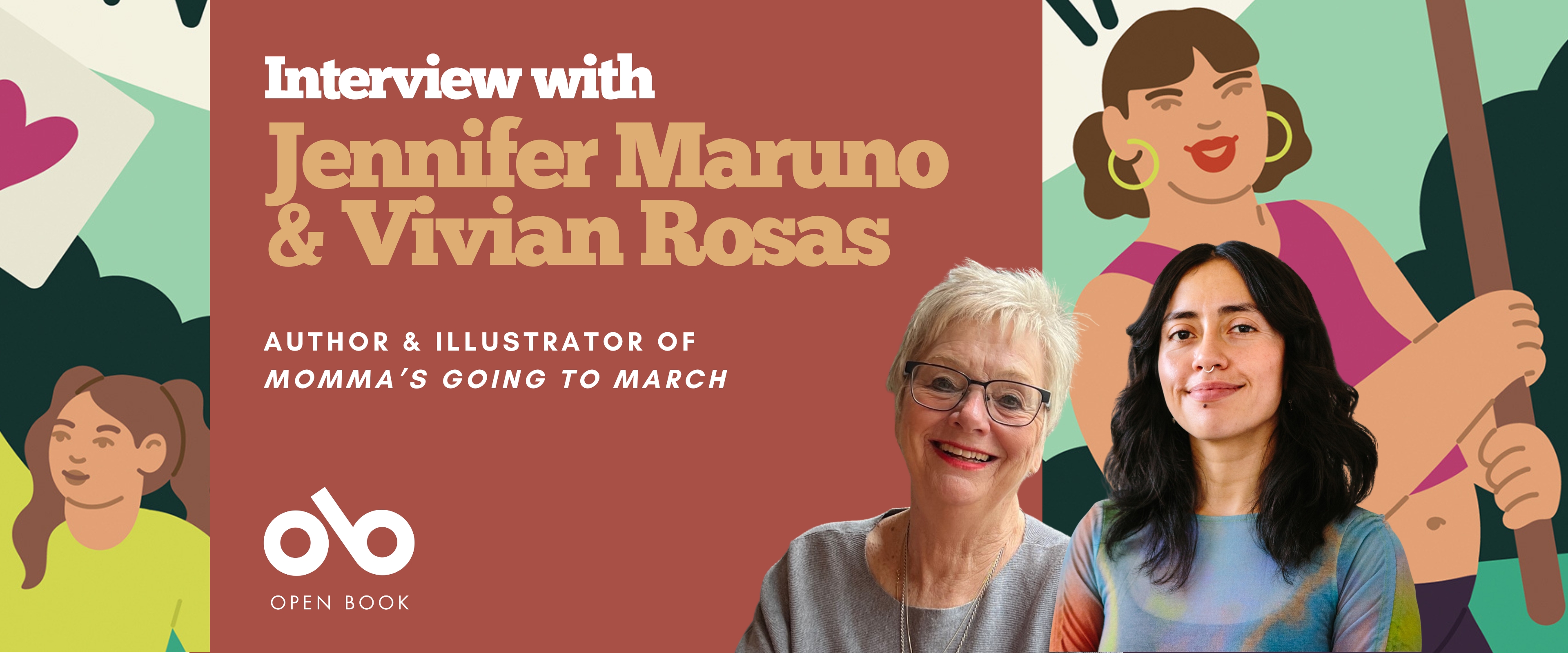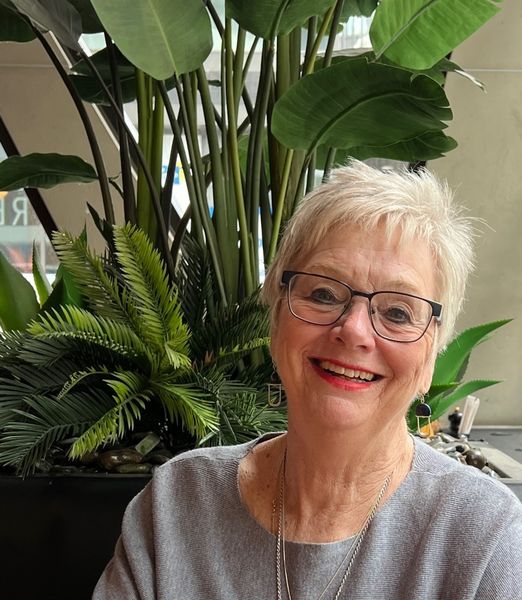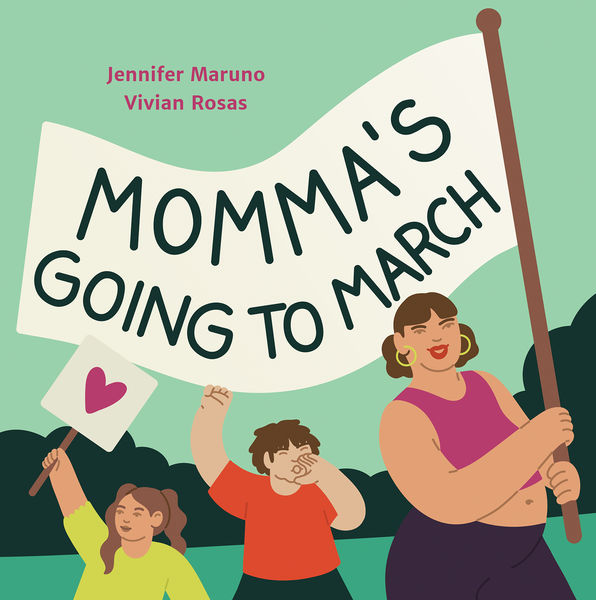Jennifer Maruno and Vivian Rosas Illustrate the Power of Peaceful Action in Momma's Going to March
Peaceful activism has long been a tool for meaningful change, and many young people are now seeing these actions with great frequency, especially as they grow up in a world where social media carries events far and wide.
Author Jennifer Maruno and illustrator Vivian Rosas know how important this topic is for the next generation, and they've captured it beautifully in the new picture book, Momma's Going to March (Groundwood Books). In the story, a number of children accompany their mothers to different peaceful protest marches, advocating for issues like freedom, equality, and the environment. They make and carry signs and banners, beat drums and fully immerse themselves in these events, and realize that they have an important place in such actions now and in years to come.
Check out this fabulous KidLit Convos interview between both the author and illustrator of this powerful picture book, where they talk about their inspiration and creative processes.
Vivian Rosas:
What was the strangest or most memorable part of creating this book for you?
Jennifer Maruno:
I was on the train one day heading into Toronto. At each stop a large group of women carrying signs boarded. I had to ask and sat back in amazement when I learned they were all heading for the Women’s March at Queen’s Park. My amazement was not that they were participating, it was that somehow I had missed that event. Why wasn’t I there too?
I thought of December 18, 1973, when 80,000 Ontario teachers walked out of their classrooms. 30,000 marched to Queen’s Park to protest Bill 274, proposed legislation that greatly affect teachers’ rights. I was part of the largest demonstration ever in the province of Ontario. This was only my second year of teaching elementary school, but the issue was important to old and new teachers, and I marched for the cause.
For the rest of the ride, I couldn’t stop thinking about the number of times women had marched in protest. My first time was as a university student. I even marched with my six-month old daughter. Did she know she took part in an historic event? As we talked, we realized many children did not know that their mother’s had marched for all kinds of reasons.
I thoroughly enjoyed the research behind the story, especially having the internet as an advantage. I spend hours reading about protest marches around the world, some ending badly for those who participated. I was, however, also learning that marching had made a difference.
Jennifer Maruno:
How do you view the elements we each contributed as working with each other in the final version?
Your CanLit News
Subscribe to Open Book’s newsletter to get local book events, literary content, writing tips, and more in your inbox
Vivian Rosas:
As an illustrator a lot of my process comes from having a back and forth with collaborators. Whether it's a client, designer or author, my work is constantly in dialogue. From time to time I get to work off my own ideas and concepts, but it’s always such a pleasure to get the opportunity to create work inspired by the words of another. The words you wrote for Momma’s Going to March were simple and effective, yet so very emotive. They painted such vivid pictures for me to build on, while giving me freedom and space to bring my perspective and view into the mix. I loved the repetition of “MARCH MARCH MARCH” throughout, which brought such a powerful energy and felt like the perfect call to action. With each spread I wanted to show the build-up of each mother/child pairing marching and getting out there with their community. Seeing the combination of your words and my illustrations in the final printed version felt so good, I feel like they really support each other in such an effortless way. Thank you for writing such inspiring words. I’m so excited for young readers to connect with our book.
Jennifer Maruno:
What was your workspace like while working on your part of the book? What do you need in order to make a work session successful (food, tools, music, rituals, etc.)
Vivian Rosas:
My home studio is a big bright room with lots of windows and lush plants. I have some of my favourite colourful artworks that inspire me hung on the walls, but other than that it’s quite minimal. It felt really good getting to work on these illustrations in such a calm and comfortable space for me. I think it comes through in the illustrations. I’ve made sure to create a space that nurtures creativity and ease for when projects like these pop up. Having a successful work session can look different day to day. When I’m in the conceptualization stage of figuring out what to draw I usually have some DJ mixes playing in the background to get my creative juices flowing. I’ll listen to anything from House music to Ambient or Downtempo depending on the day. Alternatively, on days where I already have the blueprint and I’m just doing colour I throw on some of my favourite comedy podcasts. A full glass of water is always on my desk, as well as a selection of healthy snacks. Walk breaks are essential too, especially when I get blocked or am having trouble pinning down an idea visually. I was working on these through spring and summer of last year so I had many opportunities to go out and soak up a bit of sun in between working.
Vivian Rosas:
What are the best and the toughest parts of collaboration on books in your opinion?
Jennifer Maruno:
As an author, I provide words. I don’t provide illustration notes, knowing if I have to further explain my meaning, my words weren’t well chosen. Once the manuscript has come through the editing process, it is up to the illustrator to interpret what you have written. That is a real “holding-you-breath” moment. You might not like the illustrations or feel they are in the wrong style or colour palette. This is because you write from images in your own head. Any setting may or may not be what I had envisioned. Any character may or may not be what I had envisioned. The author has passed the ball, so to speak, to a new player.
I was so very surprised when I first saw your interpretations of my settings and characters. The colours were so much more vibrant than the ones I carried in my head. You brought such power to the phrase “MARCH, MARCH, MARCH” each time it was used. I really liked the action you were able to bring to the page, by adding the various signs, ages and stages of people as well as their diversity. Thank you for bringing my words to life.
Vivian Rosas:
What do you hope young readers will take away from our book?
Jennifer Maruno:
The Conservative government backed down as a result of the 1973 march and teachers won full bargaining rights. This was the power of a united front. This is how change can occur without violence or damage.
There is a tremendous amount of violence celebrated on television, in movies and video games. Street violence is also occurring at a rapid rate. Violence is not an action that should be accepted as a way of solving conflicts. Changes can be made without resorting to it.
Readers of all ages will be encouraged to make their views and beliefs known through peaceful protest. The key concept here is to demonstrate with respect. Walking or marching for a cause is an admirable way of helping the world as well as shedding light on a prominent issue.
Momma’s Going to March is an introduction to living in a democratic society. It provides a perfect venue for adults and children who want to discuss ways of making the world a better place.
Jennifer Maruno:
Is there anything you want to tell me about your experience working on this book?
Vivian Rosas:
From the moment I received the manuscript to completing the illustrations, everything about working on this book felt easeful. The theme of Momma’s Going to March really resonated with me as someone who works hard to show up for causes that are important and as an aunt to two special little ones. I was so excited to get to work on a book that would open the door to important conversations with young children around organizing and activism. It’s so essential to start sharing these stories with kids when they are young, to show them that a difference can be made when we show up united. While I was working on the illustrations I also spent a lot of time with the mothers and kids I know in my life. These friends and family members showed me how they show up for their communities and families, which moved me to honour them by referencing visual elements or features of theirs in the character designs throughout the book. I’m always inspired by the people I know, but it was particularly special to be able to include these little easter eggs for my loved ones in such a special book. I even dedicated the book to my niece and nephew, who I know will make a difference in the world just like the kids in Momma’s Going to March.
________________________________________________
Jennifer Maruno, retired elementary school principal, is the author of seven novels for middle grade and young adult readers as well as two picture books. Former Vice-President of the CANSCAIP, among other literary roles, Jennifer currently enjoys mentoring other writers. Her latest picture book, While You Sleep, published in 2022 by Pajama Press received starred reviews from Kirkus and Quill and Quire. She lives in Burlington, Ontario.
Vivian Rosas is a Toronto, Ontario-based queer, Mestizx/Latinx multidisciplinary illustrator, dancer, and muralist. Feminism, empowerment, and diversity are recurring themes in her work. Her goal is to create imagery that expresses a sense of inclusiveness for underrepresented communities. She is the illustrator of Better Connected: How Girls Are Using Social Media for Good by Tanya Lloyd Kyi and Julia Kyi.







